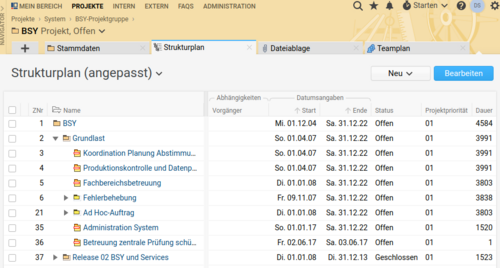Jointly successful project management
Case Study of the HanseMerkur Insurance Group
HanseMerkur's philosophy is to provide consumers with personal and individual advice to ensure the best possible insurance coverage. The Projektron BCS project management software enables us to keep the costs of our IT projects transparent.
For the long-established HanseMerkur Insurance Group, the focus is on people. We offer our customers a range of innovative and award-winning insurance products as well as excellent service. This concept has proven itself. For years, growth has been well above the industry average.
In the 2020 financial year, the HanseMerkur Insurance Group was able to report gross premium income of 2.6 billion euros with more than 2,200 employees and self-employed agency owners in the office and in the field. The investment portfolio grew to over 10 billion euros. Today, HanseMerkur is the only independent insurance group in the Hamburg financial center.
HanseMerkur and Projektron BCS
HanseMerkur has been using the web-based project management software Projektron BCS since the 4th quarter of 2004. The software was designed to support us in standardizing and optimizing the planning, calculation, coordination and evaluation of project expenses as well as expenses in the maintenance area. In particular, the planning and controlling processes were to be simplified. Projektron BCS replaced various planning, effort recording and controlling tools.
Initially, Projektron BCS was used exclusively in the application development department to plan and book the company's own expenses for application systems, IT components and IT projects. Today, the user base has expanded to include the IT operations department and project staff from the specialist departments.
Now, all projects at HanseMerkur can be planned and evaluated across departments with the support of Projektron BCS. Currently, approximately 620 employees at HanseMerkur work with the software. Over time, well over 11,000 tasks were created in Projektron BCS and were available for time booking.
Uniform project roles
The cross-departmental deployment required a uniform planning understanding and procedure as well as a uniform project understanding. Here, the different interests of those involved had to be weighed against each other and mapped in Projektron BCS. The following project roles are defined for this purpose:
- The planner of a project plans the achievement of the project goal with subprojects, work packages, tasks and milestones and assigns resources (internal and external) and efforts to the tasks. The focus here is on the available capacities, the utilization of the required staff, and the deadlines and costs.
- HR managers need to be able to view the current planning status for each of their employees across all tasks, including those outside their own area of responsibility.
- Cross-project multi-project management requires an overall view of all company-relevant projects with regard to their available project capacities, current planning status and project progress.
- Individual employees must have access to precisely those posting items for time recording that they need in order to record their time quickly and efficiently and to be able to provide rapid feedback on the status of their work, i.e. on the ratio of remaining work required to the planned completion date.
From basic loads and templates
Employees at HanseMerkur are generally not released for projects, but keep their tasks in line. Static budgeting, e.g. of the various maintenance tasks, set-up and distribution times, appeared too inflexible, since they do not occur evenly distributed over the year. Planning these tasks as a project, in turn, seemed too costly.
The "base load" (counterpart to project capacity), HanseMerkur's in-house concept as a low-effort solution for this issue, was easy to map in Projektron BCS. Over the course of several years of Projektron BCS use, the current mapping structure for projects, systems and components has evolved according to HanseMerkur's needs.
The flexibility of the software was very helpful in meeting the recurring change requirements. Today, templates are used for typical planning objects, which support the creation of new components or projects, for example, and ensure a standardization of structures. The administrative effort could thus be reduced and the concentration on the contents increased.
Time recording with Projektron BCS
The effort expended is booked in 15-minute units. This approach seems to offer a balanced relationship between high quality effort figures on the one hand and low effort for pure time recording on the other. At least every 15 days, the planner checks the actual values of "his project" and revises "his planned values" accordingly. In this way, new project developments can be identified at a very early stage and appropriate measures can be taken.
Conclusion
By using Projektron BCS, HanseMerkur has succeeded in achieving cost and planning transparency in the large number of projects and line tasks of the IT department.
The planning and execution of projects and operational tasks could thus be optimized. Capacity bottlenecks are identified at an early stage. This transparency promotes cost awareness among in-house clients, enables a well-founded profitability analysis and facilitates resource planning.
The support from Projektron is very good. Inquiries are handled quickly and competently via the Projektron BCS ticket system.












